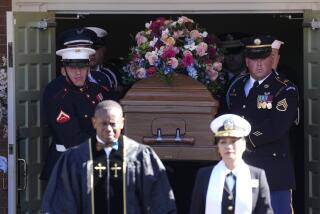Marion Carpenter, 82; ‘40s News Photographer Died in Obscurity
Marion Carpenter, one of the first women to be a White House photographer, who traveled with President Harry Truman and covered him daily, has died. Although Carpenter broke ground in her profession, she died alone and destitute at the age of 82.
Her body was found Oct. 29, it was reported this week, on a couch at her St. Paul, Minn., home, bundled up tightly against the cold because the thermostat had been lowered to save money.
The body is still at the county medical examiner’s office while friends -- most of whom Carpenter met at garage sales or thrift shops -- try to track down her only child, a son whom she had not seen in more than 30 years.
“She sounds like the type of woman upon whose shoulders we all stand,” said Susy Shultz, president of the Journalism and Women Symposium. “It’s sad that we don’t know about a Marion Carpenter. The women who came along in the ‘30s, ‘40s and ‘50s had it the hardest. They were the women breaking paths.”
In the 1940s, Carpenter was one of the first women in the White House News Photographers’ Assn. She was the only woman among a handful of photographers who traveled with Truman.
Her unique status made critics of some of her male colleagues, such as Washington Times-Herald columnist Tris Coffin, who complained in print that she used her feminine charms -- “smiled and teased” -- to persuade politicians to pose for her.
When Carpenter saw Coffin in the Senate restaurant, she sloshed a bowl of navy bean soup over his face, then stalked out. A photograph of the incident was published with the headline “Carpenter Nails Coffin.”
“I don’t have to smile or tease anyone to get them to pose,” she later told a reporter.
Carpenter studied photography in St. Paul and went to Washington when she was about 24. She won the White House job as a photographer for the International News Photos syndicate.
In her belongings when she died were photos she took of Truman, which the president inscribed to “Miss Carpenter.”
One of the photos, which shows Truman striding uphill toward the Washington Monument, bears the message: “It’s good exercise if you keep it up, but not for high-heeled shoes, Miss Carpenter.”
How her life unraveled is a book with many missing pages.
“This is a story and a half,” said a friend, Beverly Allstopp. “But we’ve all just got pieces of a jigsaw puzzle. Marion was a very private person, and she kept a lot of things from everybody.”
According to what she told her friends late in life, a love affair with a married man may have helped end her career prematurely.
Carpenter’s marriage to a Navy officer who abused her ended in divorce. In Washington, she fell in love with a Capitol journalist. When the affair ended, Carpenter remarried. Her new husband, a radio announcer, took her to Denver, where they had a son. By 1951, the marriage -- and her career -- were over. She was 31.
Back in St. Paul, Carpenter ran a wedding photo business and worked as a nurse to support her mother and child.
In her later years, Carpenter passed time at thrift shops, sitting on used furniture while browsing through old copies of National Geographic.
Carpenter showed magazines to friends and explained why photographs were composed the way they were.
“She was sensitive, and kind, with an overflowing heart,” Allstopp said. “But that heart covered up a lot of bitterness.... She had a heartache, and I think it caused her to be a recluse.”
More to Read
Sign up for Essential California
The most important California stories and recommendations in your inbox every morning.
You may occasionally receive promotional content from the Los Angeles Times.










